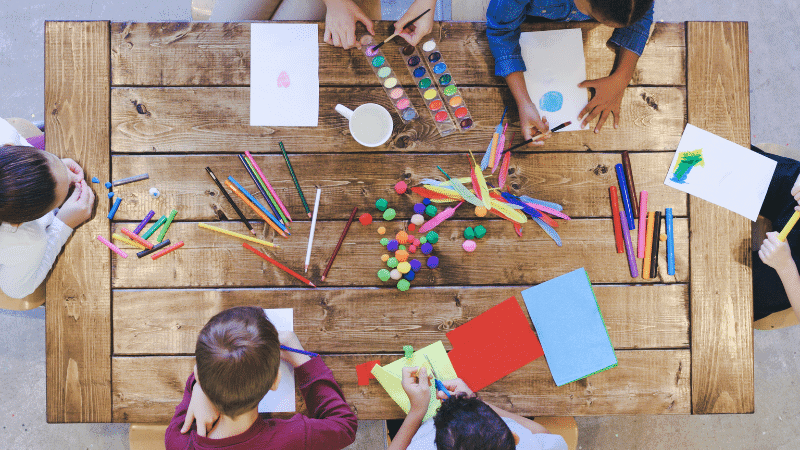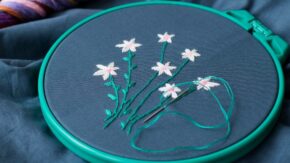Nobody’s born with the gift of the gab and we all need creative ways to encourage us to pick up language development skills better.
Did you know that art can help children improve language and communication skills?
When kids first dip their hands in paint curiously or move on to draw with a brush, they are thrilled. They want to express how they feel with their very own artistic creations. And that’s when their language development skills get on a fast track.
In this article, we discuss why and how art can help language development in children to be better communicators.
Why Do Children Need Art?

Art is simple for children to pick up and enjoy. They may like sitting and reading an educational book, but it can soon lead to boredom.
Moreover, art is an activity that children pick up early without you even guiding them. Just give your toddler some crayons, and your whole house will turn into a painting.
If you introduce art to them early – once your toddler starts talking – they will communicate and understand better. You may find some art on the wall by your little Picasso.
Art can be both fun and educational. It can serve as a language development technique and teach various skills. Let’s have a look at how art builds up language.
- Building Vocabulary
Children love learning in visual ways. Talking to children about their art helps build vocabulary skills, develop new ideas, and sharpen their observation skills.
Kids will try to describe their art from realistic, emotional, and aesthetic perspectives. The discussions can be pretty funny with your toddler, which will help with their sense of humor.
Even if you describe your child’s art from your perspective, they will try to understand you and start developing analytical skills.
- Developing Listening Skills
We learn words as we listen, making “listening” our most important communication system. When we talk, children first hear, interpret, evaluate, and react. It’s the whole process of listening.
Music is also a form of art. When you sing to your child, they go through the process of listening and react to it by smiling, giggling, etc. They learn to understand different tones and even words through music.
- Building Confidence
Many children are too shy to speak. They stumble with voicing certain words, making them feel uncomfortable and unsafe. Art can help express their observations in visuals. They can easily communicate through it. Music, art, singing, dancing, etc. allows children to participate and feel more confident in themselves.
How Are Art and Language Connected?
Art has always been a medium of visual expression. Many artists paint what they feel, so art varies from one to the other.
Art helps children to explore, discover, and experiment. Learning takes place even with incomplete drawings. Without asking them to finish the piece, ask them why they made it in the first place. Ask why they used the colors they did and what inspired them.
It helps them learn words, colors, shapes, textures, verbs, and grammar in general. If they make a mistake in a sentence, correct them in a way so that they learn. Also, teach them new shapes, colors, animals, fruits, flowers, etc.
As art helps develop new skills, it becomes part of the learning process, connecting art and language.
Encourage Creativity
Support your child’s creative journey. Provide them with different art materials, such as watercolors, crayons, yarn, pens, pencils, etc.
Don’t forget to give them a canvas to draw on. It can be coloring books, white pages, whiteboards, or cardboard boxes.
Encourage children to try new things to learn about different materials and art techniques.
Talking about art can help children work on their language skills as they describe their drawings, colors, shapes, and sizes to others.
The best things that adults can do to help are:
- Ask open-ended questions like, “Why do you make this drawing?,” and “Are those your favorite colors?”
Try describing to your child what they are doing, such as “You are drawing a square now,” “You are using green and red crayons,” or “You made a circle on your picture.” These will help them learn new words and improve language fluency.
- Ask children to describe the art process. It will help them develop communication skills.
- Write the words on a page you describe to your child and show them. Read it back to them and explain what it means.
- Encourage your child by saying, “Wow, good job!” or “That’s a very nice drawing.” It will help to boost your child’s confidence.
- Try not to control their creativity. Kids will get annoyed if you try to control their artistic creations. Yes, maybe you prefer things projected realistically, but kids might not see it that way.
Let them have their way! To show more support, provide them with various materials, such as popsicle sticks, yarns, fabric, cotton balls, rocks, etc.
- Believe in the process of your child’s art. Kids see the world very differently, and they try to depict it through art. Sometimes, you may praise them only for their results, but this will motivate them to finish something just to please you.
Instead, try praising their hard work even if the art is incomplete. It implies not only art but other things too. It will help them enjoy something and do it of their free will.
- Let them enjoy themselves. As long as your child is not playing with sharp objects like scissors, let them be themselves. They might waste all the pencils by sharpening them or the watercolors by painting themselves; they will learn through error, exploration, and fun. Keep in mind the more they enjoy, the more they know!
Conclusion
Teaching language is not about just sitting at a desk with books and papers. Many children find it hard to read books and thus lag behind in language skills.
Or, they are too invested in screen time to raise their head and talk to you. Limit their time on the cell phone or tab and encourage them to draw and paint or just tap on the piano. You’d be surprised how art can help children with language development.



